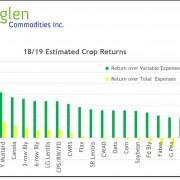Performance Management: A Post-Harvest Checklist
With harvest done, or nearly done, across the prairies, this is the time to engage in a little retrospect.
Recognizing the window is small (and shrinking) to get all the fall work done before freeze-up, this task
may end up a notch or two down the priority list. But nonetheless, it is important to go through this
exercise now that the crop is in the bin.
1. Evaluate actual yields against expected yield
Determine why your yields did, or did not, meet expectations. Not meeting expectations could
be positive or negative, and knowing what you did to control the outcome is important to either
repeat the practice, or learn from the shortcoming.
2. Assign a value to your production
This will be a combination of the prices you’ve already contracted and the current street price
on unpriced grain. Be accurate here; it does you no good to overstate the value or quantity of
your inventory.
3. Determine your current Working Capital
Once you’ve got a value for your total grain on hand, consider the rest of your current assets
and current liabilities to determine your working capital. This is the point in each operating year
(right after harvest) where working capital should be strongest. If it currently is not, seek help.
4. Production Cost and Fixed Cost Review
Looking at your whole operation as one figure does not provide sufficient information to afford
opportunity to increase management and profits. Break it down by crop and by acre. Where are
your positive points? Where are your stress points? What was your equipment cost per acre on
your cereal crops in 2015? What is your unit cost of production on that new land you rented this
year?
5. Field and Crop Analysis
Which fields were profitable? Which crops were profitable? Did you have significant variability
in some fields and/or crops? If so, how are you managing that?
6. Cash Flow Projection
Working capital versus future cash obligations gives you a clear understanding of what your cash
flow will look like over the next several months. Consider your expected cash flow in the near
term with your projections for 2016 (you will be working on those, right?) Does this affect your
expectations for next year?
7. Current Year Tax Analysis
There are less than 10 weeks remaining in the calendar year, and if your year-end matches the
calendar, you’ve got a small window of time remaining to determine what your tax situation will
look like and enact prudent business decisions accordingly.
8. Accrual Financial Statements
Whether you are incorporated or not, you should be having your accountant prepare financial
statements. If those statements have not been accrued in the past, please start now. Accrued
financial statements are the only way to truly gauge your business performance for the fiscal
year. (HINT: old statements can be accrued and presented again for management purposes.)
From the Home Quarter
One of my favorite adages is “If you don’t measure it, how can you manage it?” You’ll notice that the
essence of the points in the check list above is heavily weighted on measuring results. Any advancement
towards innovation in your business is lost if results are not accurately measured. Take the time now
that you’ve got the time to collect your data, analyze the results, and manage your performance.












Leave a Reply
Want to join the discussion?Feel free to contribute!